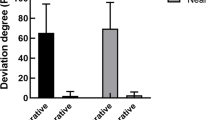Abstract
Purpose
To validate the effectiveness of the selective wavelength filter analysis with infrared photographs for diagnosing small-angle esotropia in children under age 4.
Methods
This is a retrospective, observational, case-control study. A total of 83 esotropes with an esodeviation of ≤ 16 prism diopters (PD) and 75 orthotropic controls under 4 years of age were included. Full-face infrared photographs were taken with a selective wavelength filter in front of either eye. The angles of esodeviation on photographs were measured with the three-dimensional Strabismus Photo Analyzer. The alternate prism and cover test or the Krimsky test were repeatedly performed to measure ocular alignment.
Results
The testability of infrared photographs using selective wavelength filters in children under 4 years of age was 85.6%. The mean angle of esodeviation was 11.3 ± 4.0 PD by manual measurements and 11.5 ± 4.4 PD by the infrared photograph analysis. Manual measurements and the infrared photograph analysis showed a strong positive correlation (R = 0.815, P < 0.001). The sensitivity and specificity of the infrared photograph analysis for detecting small-angle esotropia were 95.2% and 77.9%, respectively, with a cutoff value of 4.0 PD.
Conclusions
The automated infrared photograph analysis was simple and effective for diagnosing small-angle esotropia in young children.




Similar content being viewed by others
References
Anwar DS, Woreta FA, Weng CY, Repka MX (2012) Incidence of esotropia developing in subjects previously diagnosed with pseudoesotropia: a pilot study. Strabismus 20:124–126. https://doi.org/10.3109/09273972.2012.702368
Gräf M, Alhammouri Q, Vieregge C, Lorenz B (2011) The Bruckner transillumination test: limited detection of small-angle esotropia. Ophthalmology 118:2504–2509. https://doi.org/10.1016/j.ophtha.2011.05.016
Silbert AL, Matta NS, Silbert DI (2012) Incidence of strabismus and amblyopia in preverbal children previously diagnosed with pseudoesotropia. J AAPOS 16:118–119. https://doi.org/10.1016/j.jaapos.2011.12.146
Raab EL (2001) Follow-up monitoring of accommodative esotropia. J AAPOS 5:246–249. https://doi.org/10.1067/mpa.2001.117570
Pediatric Eye Disease Investigator Group (2009) Interobserver reliability of the prism and alternate cover test in children with esotropia. Arch Ophthalmol 127:59–65. https://doi.org/10.1001/archophthalmol.2008.548
Yang HK, Han SB, Hwang JM, Kim YJ, Jeong CB, Kim KG (2012) Assessment of binocular alignment using the three-dimensional Strabismus Photo Analyzer. Br J Ophthalmol 96:78–82. https://doi.org/10.1136/bjophthalmol-2011-300305
Yang HK, Seo JM, Hwang JM, Kim KG (2013) Automated analysis of binocular alignment using an infrared camera and selective wavelength filter. Invest Ophthalmol Vis Sci 54:2733–2737. https://doi.org/10.1167/iovs.12-11400
Bland JM, Altman DG (1999) Measuring agreement in method comparison studies. Stat Methods Med Res 8:135–160. https://doi.org/10.1177/096228029900800204
Choi BC (1998) Slopes of a receiver operating characteristic curve and likelihood ratios for a diagnostic test. Am J Epidemiol 148:1127–1132
Han S, Kim US (2014) Symptom based diagnosis of infant under one year in outpatient clinic. Korean J Ophthalmol 28:241–245. https://doi.org/10.3341/kjo.2014.28.3.241
Fu VL, Stager DR, Birch EE (2007) Progression of intermittent, small-angle, and variable esotropia in infancy. Invest Ophthalmol Vis Sci 48:661–664. https://doi.org/10.1167/iovs.06-0717
Hrynchak PK, Herriot C, Irving EL (2010) Comparison of alternate cover test reliability at near in non-strabismus between experienced and novice examiners. Ophthalmic Physiol Opt 30:304–309. https://doi.org/10.1111/j.1475-1313.2010.00723.x
Von Noorden GK (2002) Binocular vision and ocular motility: theory and management of strabismus. Mosby, St. Louis
Yang HK, Hwang JM (2011) The effect of target size and accommodation on the distant angle of deviation in intermittent exotropia. Am J Ophthalmol 151:907–913 e901. https://doi.org/10.1016/j.ajo.2010.11.021
Multi-ethnic Pediatric Eye Disease Study Group (2008) Prevalence of amblyopia and strabismus in African American and Hispanic children ages 6 to 72 months: the multi-ethnic pediatric eye disease study. Ophthalmology 115:1229–1236. https://doi.org/10.1016/j.ophtha.2007.08.001
Funding
This research was supported by the SNUBH research fund (No. 02-2016-051).
Author information
Authors and Affiliations
Corresponding author
Ethics declarations
Competing interests
The authors declare that they have no conflict of interest.
Ethics approval
Ethics approval was provided by the Institutional Review Board of Seoul National University Bundang Hospital. All aspects of the research protocol were in compliance with the Declarations of Helsinki.
Additional information
Publisher’s Note
Springer Nature remains neutral with regard to jurisdictional claims in published maps and institutional affiliations.
Rights and permissions
About this article
Cite this article
Yoo, Y.J., Yang, H.K., Seo, JM. et al. Infrared photographs with a selective wavelength filter to diagnose small-angle esotropia in young children. Graefes Arch Clin Exp Ophthalmol 257, 645–650 (2019). https://doi.org/10.1007/s00417-019-04240-2
Received:
Revised:
Accepted:
Published:
Issue Date:
DOI: https://doi.org/10.1007/s00417-019-04240-2




